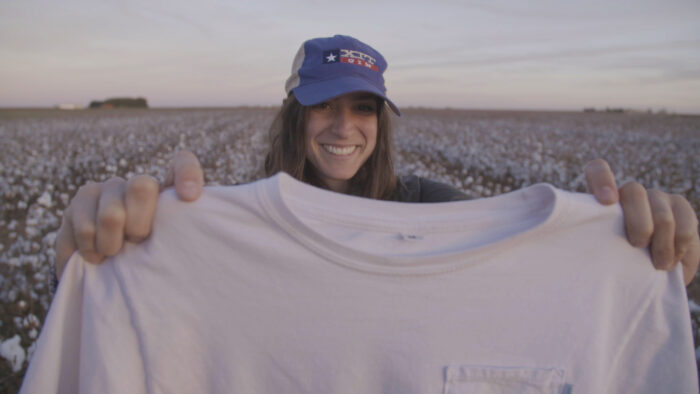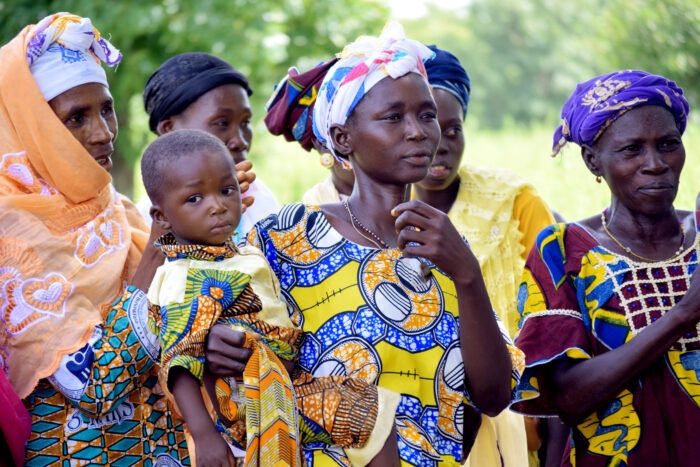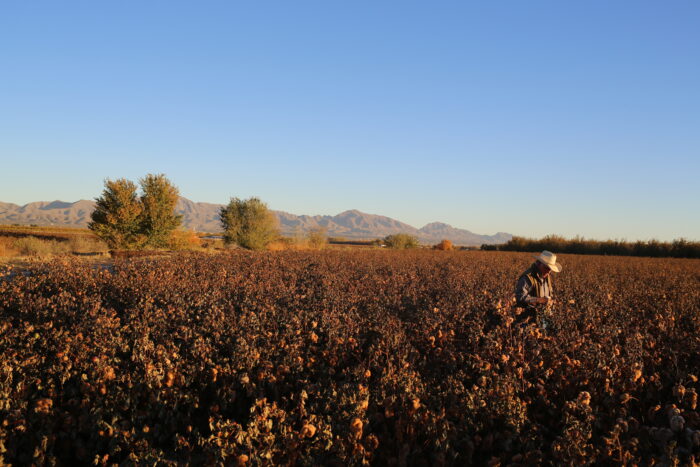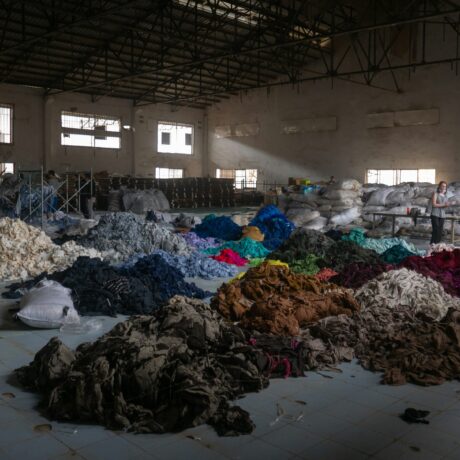Lessons from the Cotton Diaries
Cotton. It’s the most widely produced natural fibre for textiles, comprising about a quarter of global textile production, and according to the Ellen MacArthur foundation, cotton crops consume about 2.5% of the Earth’s cultivatable land. As we explore the pain points and the possibilities of our material world, Marzia Lanfranchi, founder and director of the Cotton Diaries answers our burning questions on cotton and corrects some big misconceptions.
COTTON AND WATER
I want to start by noting that there is a common perception that cotton is a “thirsty crop” (also fueled in the UK by the recent Stacey Dooley’s documentary “Fashion Dirty Secrets”).
I only found out this during my travels with Cotton Diaries, because if there was one thing that infuriates cotton technical experts is this “cotton = thirsty crop” myth.
Let’s clarify: yes, cotton requires water (like all crops), but it is actually considered a desert crop, with a deep root system that’s ideal for arid climates. Cotton uses about the same amount of water as other summer crops. It is salinity and drought tolerant and uses less water than rice, maize, soybeans and many vegetable crops.
The key sustainability issues with cotton and water come from management practices: water depletion (irrigated cotton only), soil salinization (generally associated with irrigated cotton) and water pollution, including eutrophication(relevant to both irrigated and rainfed cotton production).
Management practices are often dictated by a number of geography-specific circumstances which include access to water, rain falls & climate, mindset, access to modern technology, finance, state legislation…
The cotton and water issue is something that should not be simplified by the fashion industry and consumers by just switching to an alternative fiber-producing crop, where we might encounter another set of problems.
Let’s put our efforts in producing less but better and save water by breaking silos in our supply chain (from seed to shelf), nurturing deeper understanding and healthy collaboration.
COTTON: SOIL AND CARBON
Conventional cotton cultivation practices damage and degrade the soil with practices such as the overuse and misuse of chemical inputs (pesticides, herbicides and fertilisers), tillage, and monoculture crop production.
Pesticides and fertilisers, when inappropriately used, can seriously decrease soil fertility. Fertiliser production and use can contribute to greenhouse gas emissions.
Having said that, if regenerative practices are put in place (conservation tillage, cover crops, crop rotation, intercropping, compost…) through cotton cultivation we have the opportunity to restore soil and even sequestrate carbon from the atmosphere.
COTTON AND PEOPLE
Cotton also has a human footprint. Socio-economic challenges in conventional cotton farming include: poor working conditions, child labour and forced labour; high debts for farmers due to the heavy use of costly inputs like pesticides and fertilisers, which also cause major health issues around farming communities; low farmer incomes under constant threat from global market volatility, and gender inequality holding back inclusive development in cotton farming communities.
Despite these challenges, cotton still provides farmers with a cash income, which alongside subsistence crops, can pay for building materials, school fees, and other household necessities. If farmed sustainably, cotton can give millions of cotton farmers worldwide a decent income and help them improve their lives.
COTTON AND SUSTAINABILITY STANDARDS
I am very much exhausted by polarisations of standards and certifications. I think we should be talking about BCI “with” and not “vs.” Organic (OCS, GOTS, Regen Organic) and “with” many other standards (and brands).
We shouldn’t talk about sustainability standards competing with one another, there is enough good to be done to form a coalition that fights not against one another but against the widely-spread harmful conventional cotton production practices. Find a space where shared learnings and mutually beneficial collaboration is prioritised in order to solve our present and future challenges.
All sustainable cotton standards can be attacked – as they have recently been – because they all made their trade-offs, they all have good and bad…
Organic represents a very small percentage (around 0.7% of the world production of cotton – accordingly to Textile Exchange) but it still manages to pioneer practices and forge mindsets that are incredibly forward-thinking, but it has challenges with quality seed availability, contamination, access to quality organic inputs for pest and weed control, admin-heavy bureaucratic system… For farmers to nail it, it’s years of struggles, like for the organic farmer I filmed in New Mexico which thanks to forward-thinking customers like Eileen Fisher or his Japanese buyers has long-lasting solid business relationships. (link)
BCI has taken sustainable cotton mainstream, they’ve achieved impressive market uptake compared to organic (they’re not that far from achieving their goal of 30% of global cotton production by end of 2020), they’ve managed to get many brands on-board that they would not otherwise sign up to organic… Two of the main arguments I often hear against BCI are that firstly, it is based on a mass-balance system which, whilst on one hand provides less complex segregation and bureaucracy systems and allows quicker adoption, on the other hand, it doesn’t fully provide full traceability down to the farm, as I understand. And the second is that it is technology-neutral, which means that they accept GMO cotton, which currently represents 80% of the global cotton area – but my question would be: without mass-balance and without allowing genetically modified seeds, would it have been possible to reach most brands and most farmers?
Then there are many other challenges that Organic and BCI are facing and they are far away from being perfect, but I would like to ignore this argument, for now.
Cotton is grown in so many different countries and due to the diversity of farming systems across the different geographic areas, the specificity of sustainability challenges locally does not allow the development of a one-size-fits-all golden standard.
While my utopia is still to have measurable common shared goals across all standards and geographies, I feel that we’re far from that and I still doubt that would be possible and it wouldn’t be developed fast enough to face our urgent challenges.
My point is that BCI, organic and many other sustainable cotton standards are just a starting point for brands. Brands have the advantage to be more agile and move faster than standards and should not rely solely on them, but rather use them as tools and benchmarks to implement their own brand due diligence. My invitation for all brands is to go beyond standards, to get to really know their supply chain down to the farm, or even to the seed – if possible – and ensure their sources are safe for their farming communities and for the environment.
PUSHING FOR CHANGE
Before asking brands, let’s say we, as consumers-citizens, should ask ourselves if we need another extra new (cheap) cotton product and if we really do, look for and demand the highest quality one that will not soon become obsolete.
For brands, we need to ask them for supply chain transparency overall, to have a due diligence approach that goes beyond certifications and standards. Brands need to be actively involved in ensuring their product is safe for the farming communities who produce it and the environment around us.
So, we should ask our beloved brands to fully know their products down to seed level and ask them how they’re ensuring that they’re investing in long term support of ecosystems and farming community safety. In addition, I think it is important that brands display good instructions on how to look after our item. If you don’t know – ask them.
Firstly, look at the quality of your cotton garment. If you want to make a difference, as a consumer, support the brands who know and are willing to tell you where their cotton comes from – not just the one that has a certification logo or a vague statement on their label.
One last comment: I do strongly believe that cotton, if done well, can be a good option (not the only one) in our portfolio of sustainable fiber.
***
If you want to learn more about cotton and sustainability, I will be publishing content and interviews from the cotton and sustainability best minds on CottonDiaries.com.











